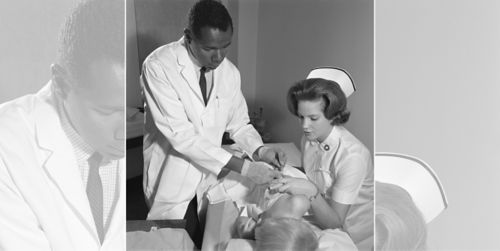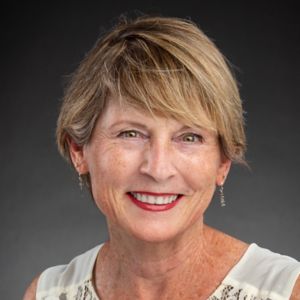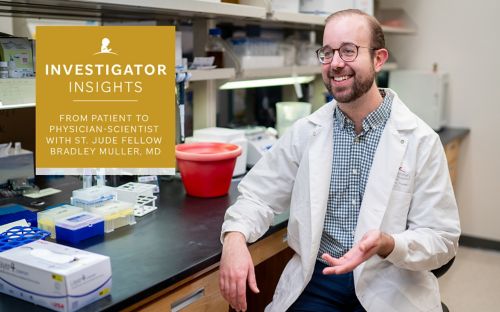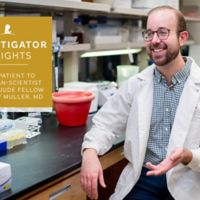Searching for John Smith: Out of the Shadows

It was a brave move for an African American who’d spent most of his life in Nebraska and California to move to Memphis and join an upstart hospital during an era of intense social unrest.
Tucked away in the photographic archives of St. Jude Children’s Research Hospital is an intriguing portrait. Captured in 1965, the image depicts a young African American man gazing pensively into the middle distance. John Wesley Smith, MD, was only three years out of medical school when he agreed to move to the South and join an upstart hospital during an era of intense social unrest. It was a brave move for a man who had spent most of his life in Nebraska and California.
No one has chronicled the life and achievements of this remarkable physician. Because he died in 1984 and most of his colleagues have retired, the clues were sparse. But Smith deserves to have his pioneering efforts brought to light, 55 years after his arrival in Memphis.
According to hospital records, Smith began his career at St. Jude on a hot July day in 1965. He would go on to treat children in the hospital’s Solid Tumor clinic and conduct research in the Virology and Infectious Diseases departments.
“John spent quite a lot of time in the lab,” says Robert Webster, PhD, emeritus faculty member. “He and Luis Borella, MD, were both clinicians who worked in the lab as well as in the clinic.”
In the clinic
During the turbulent 1960s, some patient families initially balked at having an African American oncologist. Hospital Director Donald Pinkel, MD, recalls an Arkansas woman who took her child and stormed out of the clinic upon seeing her child’s doctor. Pinkel spoke with her and explained that Smith was an accomplished physician, convincing her to return to the hospital and trust her child to Smith’s care.
“We were colleagues in the Department of Hematology-Oncology,” recalls emeritus faculty member Gaston Rivera, MD, who arrived at St. Jude in 1970. “John saw the patients with tumors, and I saw the patients with leukemia. He was well-liked by everybody—his colleagues, the nurses. He also had a wonderful rapport with his patients.”
Smith eventually became head of the hospital’s outpatient clinic.
Research pioneer
Online genealogical records tell us that Smith was born in Omaha, Nebraska, to Geraldine Smith, a housekeeper with a 10th grade education. When he was a teenager, his family moved to Los Angeles. During a stint in the Army, beginning at age 20, he traveled from California to Germany. Smith earned a bachelor’s degree from UCLA and a medical degree from Howard University in Washington, D.C.
He began his research career at St. Jude in the Virology laboratory, exploring the relationship between childhood cancer and viruses. The hospital’s 1965 annual report shows that he and eight Virology colleagues conducted studies on the Lucké tumor, Newcastle disease virus and murine leukemia viruses. In 1966, their research included rhabdomyosarcoma, a muscle cancer. That year, Smith and his colleagues, including hospital director Donald Pinkel, MD, spoke to the Southern Society for Pediatric Research about the association of a virus with embryonal rhabdomyosarcoma. The following year, he, Pinkel and another scientist published “Search for a Human Leukemia Virus,” which chronicled their search for viruses in the blood and bone marrow of 107 children with leukemia. “Studies are in progress on a continuous leukemic bone marrow culture to recover in recognizable form either replicating virus or viral genome,” they wrote.
In 1970, Smith transferred into the Infectious Diseases department. Most children who died at St. Jude were succumbing to infections rather than cancer. In fact, the mortality rate from infectious diseases had increased dramatically—from 57% in 1962 to 91% in 1969. In the battle against Pneumocystis carinii pneumonia, Smith worked alongside Walter Hughes, MD, who would eventually be hailed as the leading authority on the disease, its prevention and treatment.
Beyond St. Jude
When Smith was not working in the lab or clinic, he served as an instructor of microbiology at the University of Tennessee College of Medicine. Pinkel recalled that the first time Smith lectured to the medical students, Allan Granoff, MD, peeked in to see the reaction.
“John got up there, and they all looked with utter amazement in their faces at this black professor that was going to give them this lecture. Then as soon as John opened his mouth, they were down in their notes, taking down everything he said….Typical medical students!” he said.
Jerry Chipman, retired St. Jude vice president for public relations, recalls Smith playing a major role in a Lillian Hellman production at Theatre Memphis.
“To my knowledge, it was his only stage appearance,” Chipman said, “and an out-of-character controversial role for John, who played the paramour of a wealthy white New Orleans society matron. He was a good guy, very quiet and soft-spoken; a real gentleman.”
One of Webster’s favorite stories about Smith revolves around a snazzy red Mustang.
“John was so proud of that car. He kept it beautifully polished,” Webster said. “When it came time to go to a scientific meeting in Nashville, John insisted the people in the lab should ride with him. There were three of us, and John was driving.
“It took two days to get to Nashville,” Webster said, chuckling. “It broke down twice on the way. That car had never been out of Memphis in its life.”
After leaving St. Jude in 1978, Smith returned to California to found the California Children’s Clinic in Hillcrest. He was a member of the American Society of Pediatric Hematology/Oncology, the Southern Society for Pediatric Research, the American Society for Microbiology, the New York Academy of Sciences and the Royal Society of Health.
Although Smith died at age 51, his legacy continues. At St. Jude, he broke down racial barriers and worked to save lives and promote scientific progress. A life well lived, out of the shadows at last.






